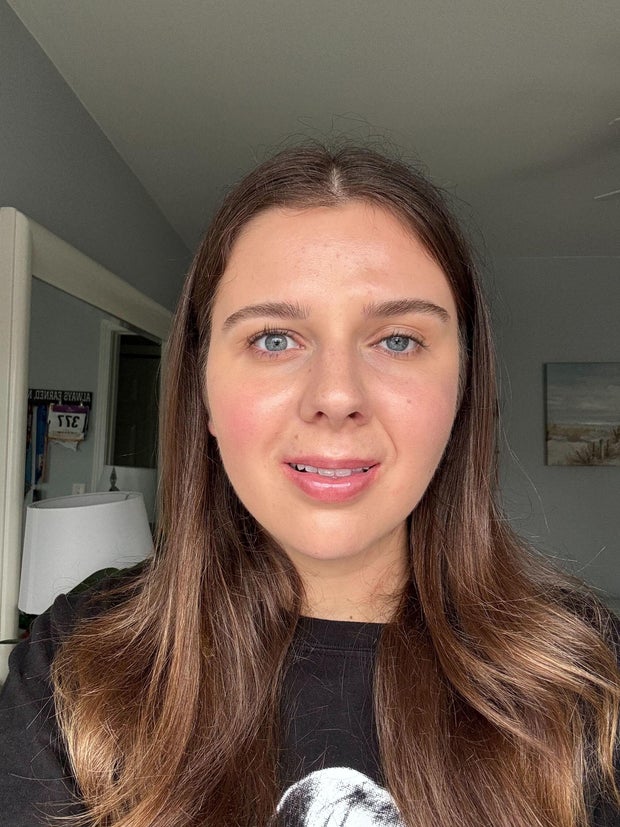A teenager started hearing a strange pulsing noise, but her mild symptoms were signs of an alarming condition
When Lizzie Clark was 13, she started experiencing a strange ringing in her left ear. At first, she thought the tinnitus-like sound was a side effect from a cold. But the cold left, and the sound lingered, pulsing in time with her heartbeat.
For months, the "strange pulsing noise" was constant, Clark told CBS News. Her parents took her to see her primary care physician, then an ear, nose and throat doctor, but it wasn't until she underwent a CT scan that doctors finally found the cause. The eighth-grader was racing in a track meet when doctors called her parents and said they had seen a growth behind her eardrum.
"I was terrified. I was 13. I was like, 'What growth? What does that mean?'" Clark recalled. "There were a lot of questions buzzing around."
Clark was diagnosed with facial nerve schwannoma, a slow-growing benign tumor. The first doctor she saw recommended immediate surgery to resect the tumor, but told Clark and her parents the operation would damage her hearing and permanently paralyze the left side of her face.
Unsatisfied with that option, Clark and her parents sought a second opinion from Dr. Pablo Recinos, a neurosurgeon at the Cleveland Clinic. He advised a more cautious route that would require careful surveillance — but might preserve Clark's hearing and facial function.
Watching and waiting
Recinos said because facial nerve tumors tend to be slow-growing, it's possible to wait before operating. Clark was young, and her tumor wasn't showing signs of growth. He began working with reconstructive surgeon Dr. Patrick Byrne, the chief of Cleveland Clinic's Integrated Surgical Institute, on a series of complex operations that could treat Clark while minimizing risk.
First, Byrne would do nerve graft surgeries that would connect the nerves on the left side of Clark's face to those on the right side. This would rewire that side and keep Clark's face functional, Recinos said. The nerve graft surgeries would be followed by a surgery to remove the tumor. It was a unique approach, and Clark was the first patient that Recinos and Byrne developed the technique on, Recinos said. They have since performed it on several other patients.
For several years, Clark had MRIs taken every six months. During that time, the tinnitus-like continued and a tube was put in Clark's ear to clear fluid that accumulated and couldn't drain naturally because of the growth. Otherwise, Clark experienced few symptoms. She even named the tumor, calling it "Teddy" so it was easier to "cope with everything."
When a photo of herself was taken in her junior year of high school, Clark noticed her smile was crooked and her face was becoming asymmetrical. Shortly afterward, she began to experience mild facial paralysis. That brought Clark and her parents back to the Cleveland Clinic. Recinos and Byrne decided those symptoms meant it was time to start operating.
Clark had the first nerve graft surgery in 2021, followed by another operation in early 2022. The procedures led to some improvement in Clark's facial asymmetry and paralysis, which had become so severe her left eye couldn't close properly. In December 2023, scans showed that the tumor had grown and was threatening to reach Clark's brain stem. Delaying the removal surgery was no longer an option.
"Excited for it to be over with"
Despite the years of preparation, there was no guarantee that Clark wouldn't lose some hearing or facial movement function after the removal surgery. In fact, Clark said she was told she would likely lose hearing on her left side, because of where the operation had to take place, and wake up with a "drastically different" appearance. There were also concerns she'd have trouble speaking as she recovered. It wasn't that different from the results she had feared when she and her parents saw their first doctor years before. Clark had hoped to wait until she finished college to get the operation, but there was no longer any time to delay. She made arrangements to take off the first semester of 2024 and scheduled the surgery for August.
"I wasn't scared, like I was at the beginning. It was more like a calm relief that the tumor was going to be gone, that there weren't going to be any more problems," Clark said. "I was ready for the tumor to come out. I had accepted the fact I was going to lose my hearing. I was talking to my parents about potentially doing an ASL class. I knew it was going to be an adjustment, but everyone was excited for it to be over with."
At 5 a.m. on Aug. 8, 2024, Clark arrived at the Cleveland Clinic for the removal surgery. Clark was so scared she hadn't slept the night before, and her mother cried as her daughter was wheeled into the operating room. They knew the operation was going to be long and arduous, and that Clark's world would look different when she woke up.
Recinos said that the 22-hour operation went smoothly. Neurotologist Dr. Anh Nguyen-Huynh operated around Clark's ear and hearing structures to reach the tumor. Once there, Recinos cut Clark's facial nerve and removed the tumor. Finally, Byrne reconstructed the area where the surgery had taken place. Clark spent another eight hours sleeping off the effects of anesthesia.
When Clark woke up, 30 hours after being wheeled into surgery, the first thing she heard was her parents speaking.
"I'm like 'That's strange. I can hear them both out of both my ears,'" Clark recalled. "I told them 'I can hear you.' My mom said, 'Is that the meds talking? Or can she actually hear us?' I'm like, 'Yeah, I can hear you guys.' That was a sense of relief."
Regaining function and looking forward
While Clark was drowsy and in some pain, she didn't have any difficulty speaking. Her facial function wasn't limited, but in fact was improving: A few days after the operation, she noticed the left side of her mouth was curving back up to its natural position and her eyelid was closing better.
Recinos said the nerve grafts before the removal surgery led to the more successful result. The nerve graft had time to regenerate and resettle in her face, he explained, allowing Clark to maintain facial function.
"It was a surprise to everyone that my face was working as well as it was, considering they just cut out my main facial nerve," said Clark. "My face doesn't look 100% like it did five years ago, but it's better than the alternative."
Clark is now waiting to return to classes at the beginning of the spring semester. She's on a pre-pharmacy school track, inspired by having spent so much time with medical professionals. A pathology report found that Clark didn't have a schwannoma like she was initially told, but a meningioma. Both types of tumors are slow-growing and can recur, so Clark will have regular follow-ups to make sure there is no new growth, Recinos said.
Clark said that she hasn't heard the ringing in her ear since waking up from the operation. That left when "Teddy" was removed, she said.
"Going to bed and hearing that whooshing noise, or when it was dead quiet and I could hear it, was really annoying me," she said. "It's very nice that it's gone."







